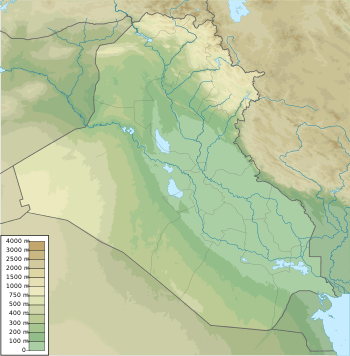Tepe Gawra
 Shown within Iraq | |
| Location | Nineveh Province, Iraq |
|---|---|
| Region | Northern Mesopotamia |
| Coordinates | 36°29′44″N 43°15′37″E / 36.49556°N 43.26028°ECoordinates: 36°29′44″N 43°15′37″E / 36.49556°N 43.26028°E |
| Type | tell |
| Site notes | |
| Excavation dates | 1927, 1931, 1932 |
| Archaeologists | E.A. Speiser |
| Wikimedia Commons has media related to Tepe Gawra. |
Tepe Gawra (or "Great Mound") is an ancient Mesopotamian settlement in northwest Iraq that was occupied between 5000 and 1500 BC. It contains the remains from the Halaf period, then the Ubaid period, and then from the Uruk period (4000–3100 BC). Tepe Gawra is one of the few sites that contain material relating to the Halaf-Ubaid Transitional period c. 5,500-5,000 BC.
History of archaeological research
A brief exploratory dig was performed by Austen Layard before 1850.[1] The site was formally excavated in 1927, 1931 and 1932 for a total of 8 months by archaeologists from a joint expedition of the University of Pennsylvania and the American Schools of Oriental Research, led by Ephraim Avigdor Speiser.[2][3][4][5][6][7]
In 2001, Mitchell Rothman reanalyzed the data from previous excavations, that did not use precise stratigraphic techniques. He considerably clarified the stratigraphy of the site.[8]
Tepe Gawra and its environment
Tepe Gawra lies near the ancient site of Nineveh, 2 miles (3.2 km) from Khorsabad and 15 miles (24 km) northeast of the modern city of Mosul. The tell or settlement mound at Tepe Gawra is 120 metres (390 ft) in diameter and 22 metres (72 ft) high.
Occupation history
Excavations at Tepe Gawri revealed 16 levels showing that the Tepe Gawra site was occupied from approximately 5000 BC to 1500 BC. They include the earliest known temple to be decorated with pilasters and recesses. The Gawra Period (3500–2900 BC) is named for the site.
See also
References
- ↑ A. H. Layard, Nineveh and Its Remains, John Murray, 1849
- ↑ E. A. Speiser, Excavations at Tepe Gawra 1, University of Pennsylvania Museum of Archaeology and Anthropology, 1935.
- ↑ Arthur Tobler,. Excavations at Tepe Gawra 2, University of Pennsylvania Museum of Archaeology and Anthropology, 1950
- ↑ E. A. Speiser, New Discoveries at Tepe Gawra and Khafaje, American Journal of Archaeology, vol. 41, no. 2, pp. 190-193, 1937
- ↑ The Expedition to Tell Billa and Tepe Gawra, Bulletin of the University Museum, University of Pennsylvania, vol. 3(2), pp. 59-66, 1931
- ↑ Developments at Tell Billa and Tepe Gawra, Bulletin of the University Museum, University of Pennsylvania, vol. 3(3/4), pp. 94-95, 1932
- ↑ Excavations at Tell Billa and Tepe Gawra, Bulletin of the University Museum, University of Pennsylvania, vol. 3(5), pp. 126-130, 1932
- ↑ Mitchell S. Rothman, Tepe Gawra: The Evolution of a Small, Prehistoric Center in Northern Iraq. University Museum Publications, 2001, ISBN 0-924171-89-8
Further reading
- Mitchell S. Rothman, Tepe Gawra: The Evolution of a Small, Prehistoric Center in Northern Iraq, University Museum Publications, 2001, ISBN 0-924171-89-8
- P. Butterlin (éd.), A propos de Tepe Gawra, le monde proto-urbain de Mésopotamie - About Tepe Gawra: a proto-urban world in Mesopotamia, Brepols Publishers, 2009, ISBN 978-2-503-53002-4
- T. E. Davidson and Hugh McKerrell, The Neutron Activation Analysis of Halaf and 'Ubaid Pottery from Tell Arpachiyah and Tepe Gawra, Iraq, vol. 42, no. 2, pp. 155–167, 1980
- E. A. Speiser, The Bearing of the Excavations at Tell Billa and at Tepe Gawra upon the Ethnic Problems of Ancient Mesopotamia, American Journal of Archaeology, vol. XXXVI, pp. 29–35, 1932
External links
- EXCAVATING TEPE GAWRA IN THE ARCHIVES OF THE UNIVERSITY OF PENNSYLVANIA MUSEUM
- Archaeological site photographs at Oriental Institute
